Recipe: Religieuse (Religious Dreams/Nuns)
Level: Intermediate
Techniques: Italian Meringue, Choux Pastry, Streusel Pastry, Creme Patissiere
Last week I received a copy of a book that I have been waiting a long time for. Philippe Conticini is a world famous pastry chef and his La Pâtisserie des Rêves are gaining pace in the UK with a second store set to open in South Kensington in July.
The English translation of La Pâtisserie des Rêves (LPDR) cookbook contains recipes for well-known pastries featured in his stores, along with recipes for pastes, creams, sauces and other accompaniments.
The book looks beautiful, stunning photography and inspiring recipes meant that I wanted to try something as soon as possible.
I’m not sure if it was stupidity or my unwavering trust of Conticini, but I thought I’d give choux pastry another bash. The recipe I settled on was religieuse, which translates as Nun and is a form of éclair.
The religieuse are said to represent a nun in a habit and they were first created in 1540 by Catherine de Medici’s Florentine pastry chef Panterelli.
The classic religieuse comprises two different sized choux cases filled with chocolate or mocha (chocolate and coffee) creme patissiere. Each case is covered with a ganache the same flavour as the filling and then the smaller choux bun is sat on top to form a head and body. Whipped cream is then piped as a decoration between the two buns and on top. Here is an example of a Laduree religieuse.
Like all French patisserie the religieuse recipe has been adapted by many patissiers, adding their own signature by changing flavours, decoration and colour. They all remain true to the iconic shape, making this pastry instantly recognisable, regardless of the variants on flavour.
Laduree, produce three types of religieuse, morello cherry and almond, the traditional chocolate and a rose and raspberry version.
The recipe from La Patisserie des Reves is also slightly different to the traditional recipe. The choux cases are topped with a streusel pastry round before baking, filled with a mocha ganache and then sandwiched together with Italian meringue, that is cooked using a chef’s blowtorch.
There were a few new techniques in this recipe for me, I haven’t made streusel pastry before, or a mocha creme patissiere and I certainly haven’t mastered choux pastry.
Working from the LPDR book made me realise how comprehensive and detailed Felder’s book is. Where the Felder book gives step by step instructions with tasks carried out in a sensible order, the LPDR just lists every component of the recipe and doesn’t advise which part to make first.
Using the experience I’d gained from Felder’s book, I made the mocha creme patissiere first, so that it would have time to set in the fridge. The recipe lists this as the third component after the streusel pastry and the choux pastry.
To make the creme patisserie, the milk was infused with ground arabica coffee (I used Lavazza) for 5 minutes and then drained through a chinois or a stocking. I didn’t have a chinois and I wasn’t sure if it meant a real stocking, even if it did, I didn’t have any of those either. I really hadn’t done my mise en place for this one.
In the back of the cupboard, I found a nylon jelly bag, bingo! It worked perfectly and I was able to strain my coffee infused milk and remove the coffee grounds. The worst part was squeezing the bag of grounds full of hot milk. Ouch!
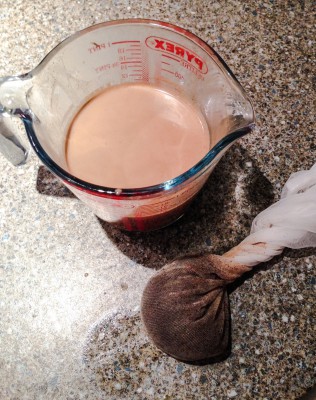
The infused milk was then poured back into a pan and dark chocolate was added, the milk was then heated so that the chocolate melted. While the chocolate melted, the egg yolks, brown sugar, cornflour and flour were whisked together until creamy and pale.
The chocolate coffee milk was added to the egg mix in stages until it combined evenly. The whole lot was then poured into a saucepan and heated again until it thickened. When the mix had thickened, butter and fleur de sel were added and the creme patissiere was put in the fridge to cool.
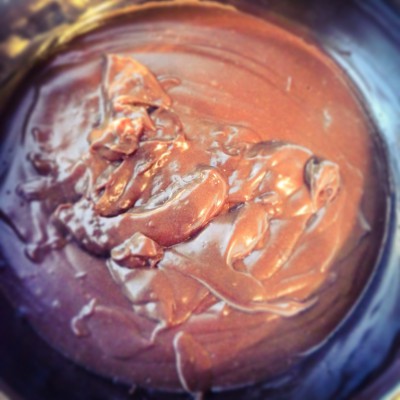
I then moved on to the streusel pastry, this was a mix of brown sugar, flour, butter and fleur de sel. I made the pastry in my Kitchenaid, it’s the first time I’ve used it for pastry and it really cut down the time it normally takes and no messy hands!
Streusel is simply a crumbly topping that is baked on top of cakes, pies etc. I rolled out the pastry and cut out 7 small and 7 large rounds and put them in the fridge to chill.
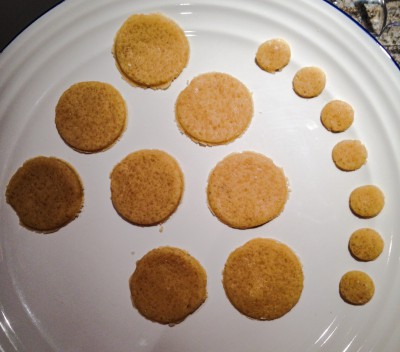
This is where I became concerned with the quantities in the recipe, I had cut out the 14 rounds as required (plus a few extra in case of any accidents) and I still had enough pastry to probably cut out another 14. Unsure of what to do, I put the pastry to one side and moved on to making the choux pastry.
Readers of this blog will know how much I fear choux pastry, I’ve had so many failures, but there is only one way to become good at something and that is practice.
Also I wanted to try another chef’s recipe to see if it was me, or the recipe in ‘the book’ that wasn’t up to scratch. Honestly, I didn’t think these were going to work and it wasn’t until I took them out of the oven that I was truly convinced of their success.
I made the choux pastry in the usual way, combining flour, sugar and salt with a mixture of warmed milk, water and melted butter. The difference in this recipe was that after cooking off the dough for a minute over a medium heat, I added it to the bowl of my kitchenaid and added the eggs, while the food mixer did all of the hard work.
The resulting pastry was thick, glossy and so much easier to pipe than when I’ve made it by hand.
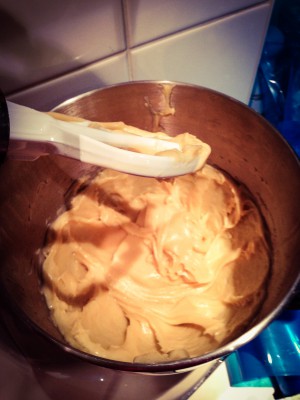
I piped the dough into 7 large and 7 small blobs and I still had so much left. So I piped out another 7 large and 7 small blobs and still had a third of a bag of pastry leftover, probably enough to make 21 religieuse in total.
I didn’t bother to pipe out any more as I’d filled two baking trays and I didn’t know how much filling I would be left with.
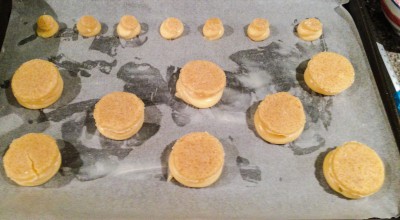
I topped the choux with the streusel pastry and baked it. I found it needed a higher temperature than specified in the LPDR book, it also needed an extra 10mins to achieve a nice golden colour. I do not blame this on the LPDR book though as ovens are very temperamental things and everybody should take time to get to know the hot spots in their own oven etc.
The finished choux was taken out of the oven and left to cool.
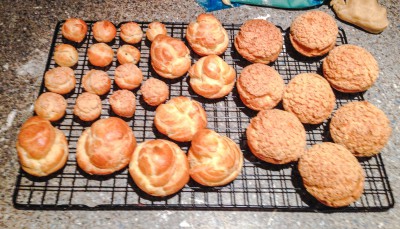
While the choux was cooling, I made the Italian meringue. I know that you need very fresh eggs for meringue and older eggs when you’re baking with meringue. Annoyingly this week some of the eggs that came as part of my online shop were broken and I had miscounted how many eggs I needed for the recipe.
I thought I had enough, but I didn’t and I had to defrost some of my frozen stash of egg whites. These eggs whites were a bit too old, I accidentally over whipped the first batch of meringue and it was unusable.
Here is a picture of the over worked meringue so that you know what to look for if you have any errors.
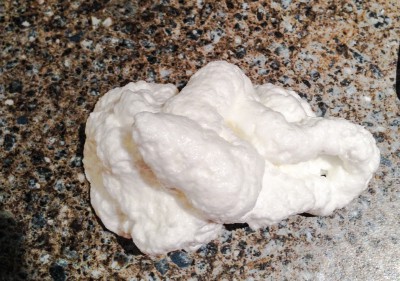
The second batch I made was better, but still not as good as previous meringues that I had made.
The final stage of the recipe was assembly. The choux buns are filled with the mocha creme patissiere, the LPDR book didn’t actually instruct me to do this step, but I knew this was what the filling was intended for. Interestingly, the creme patissiere recipe made just enough to generously fill 7 of the religieuse.
I piped meringue on top of the large choux pastry case and then sat a smaller case on top with a small blob of meringue sat atop of it. I then had to use my blow torch to crisp up the meringue and give it a nice brown colour.
The finished religieuse tasted wonderful. The recipe for choux pastry was fantastic and I will use this recipe in future, however the fact that the recipe made more than 3 times the quantity required was frustrating. A simple note that this made more pastry than needed would’ve sufficed. Then I could’ve made some choux buns and bought something to fill them with.
The streusel recipe also made more than required for the religieuse and there was meringue left over, the lack of instruction about filling the choux cases was confusing as well.
I did email the UK publishers about my results with this recipe and they have said that they will pass my comments on to the French publishers.
Despite these minor inconveniences, the religieuse tasted fantastic, the creme patissiere was rich and creamy, the choux light and crispy and the crunch provided by the streusel was delicious.
I will make these again and I will continue to bake from La Patisserie des Reves cookbook as it has some other wonderful looking recipes I cannot wait to try.
To create the Religieuse yourself or the coffee chocolate creme patisserie, take a look at the recipe.
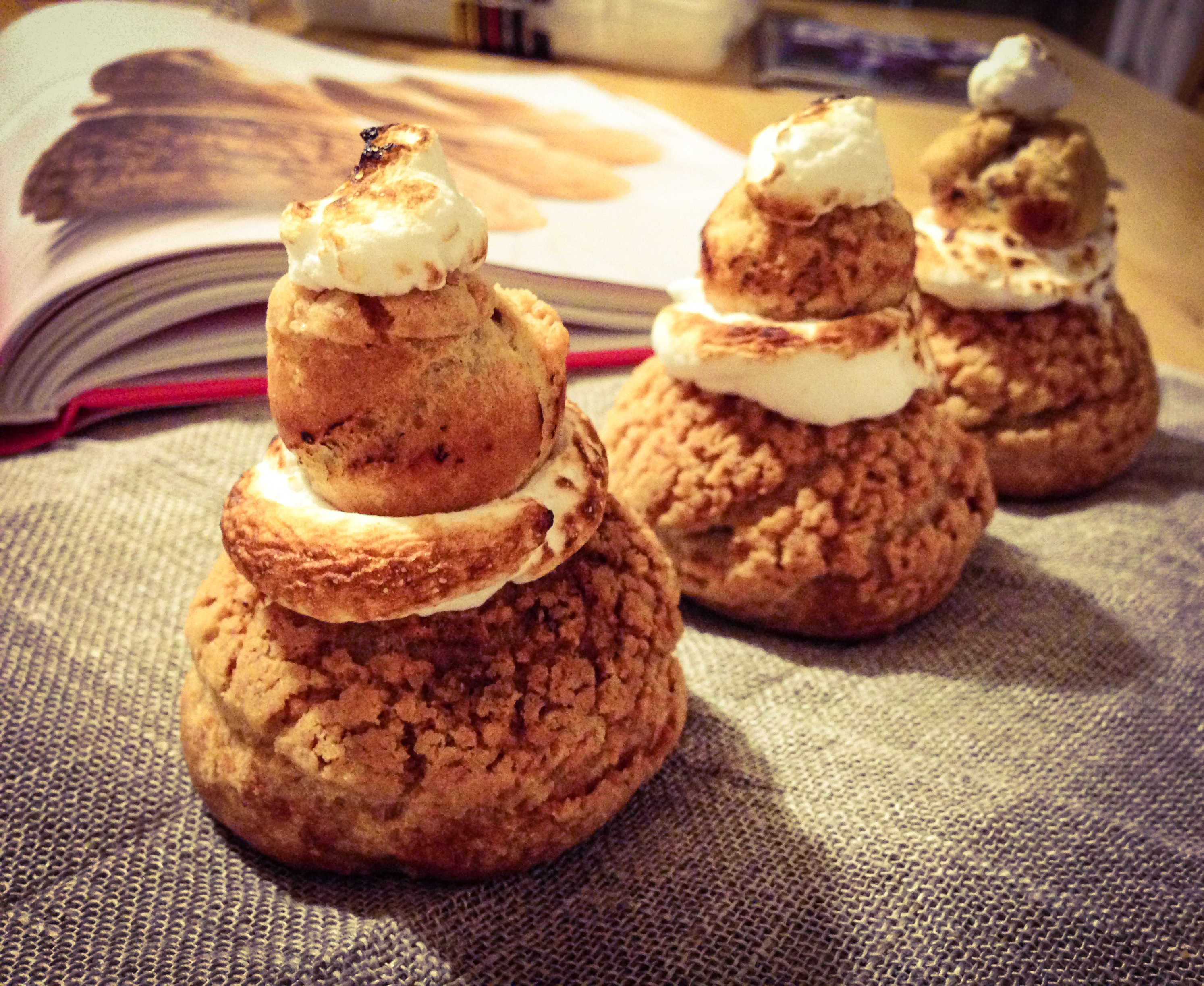
Religieuse
Ingredients
- ***CHOUX PASTRY in an ELECTRIC MIXER***
- 60 ml Water
- 60 ml Semi-skimmed milk
- 3 eggs
- 55 g butter
- 70 g Plain flour
- 1/2 heaped tsp of white sugar
- 1/2 level tsp of table salt
- ***STREUSEL PASTRY***
- 20 g Cold butter
- 25 g Brown sugar cassonade or demerara
- 25 g Plain flour
- 1 Pinch of fleur de sel
- ***ITALIAN MERINGUE***
- 100 g Caster sugar
- 20 ml Water
- 2 Egg whites 60g
Instructions
- ***FOR THE STREUSEL PASTRY***
- Combine the butter, sugar, flour and salt in the bowl of a food mixer and beat with the paddle attachment until the mixture forms a dough and pulls away from the sides of the bowl.
- Roll the pastry out on a floured surface to a thickness of 2mm.
- Using a pastry cutter or a small glass to guide you, cut out 7 streusel rounds 2cm in diameter and 7 rounds 4cm in diameter.
- Place in the fridge to chill.
- ***FOR THE CHOUX PASTRY***
- Sift the flour, sugar and salt into a bowl.
- Cut the butter into chunks and place in a saucepan with the milk and the water.
- Heat the mixture until it boils, then add the flour mixture.
- Stir carefully using a wooden spoon, a dough will form immediately. Continue stirring over a medium heat for 1 minute until the dough comes away from the sides of the pan.
- Now tip the dough into the bowl of the electric mixer, then knead with the paddle attachment incorporating the eggs one at a time. You should obtain a pliable, glossy choux pastry.
- Grease a baking tray with butter and line it with greaseproof paper and use a piping bag to pipe the 7 small choux buns (the 'heads' 2cm in diameter) and 7 large buns (the 'bodies' 4cm in diameter).
- Place the corresponding sized streusel rounds on the choux buns.
- Bake at 170 degrees (gas mark 3 to 4), giving the small buns about 15 minutes and the large ones 25 minutes or until they are golden. Then allow to cool completely at room temperature.
- ***FOR THE ITALIAN MERINGUE***
- In a saucepan heat the sugar and water to 118 degrees.
- When the syrup reaches 100 degrees start whisking the egg whites in a freestanding mixer at medium speed.
- When the whites are frothy, gradually pour in the sugar syrup when it has reached the desired temperature.
- Keep whisking the egg whites until they are glossy and form peaks. Use the meringue immediately.
- ***TO ASSEMBLE***
- Fill the choux buns with the coffee chocolate creme patissiere,by making a whole in the bottom and piping in the filling.
- Put the meringue in a piping bag and pipe a blob on the large buns and stick the small buns on top, gently pressing down on the knob of meringue.
- Pipe a bit of meringue on top of the small bun and scorch them with a blast from the blow torch.
Thanks for reading.
Angela
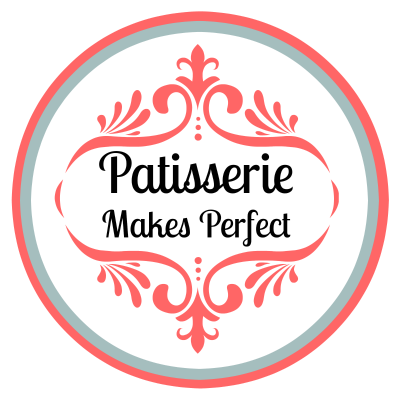
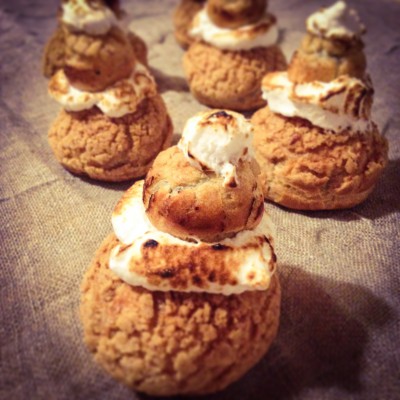
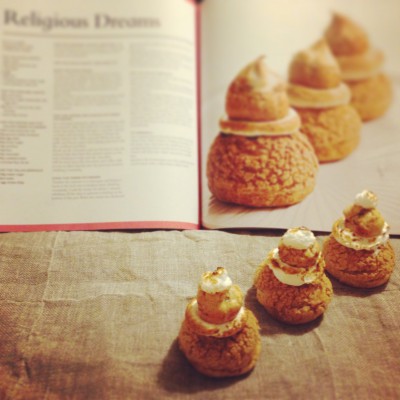
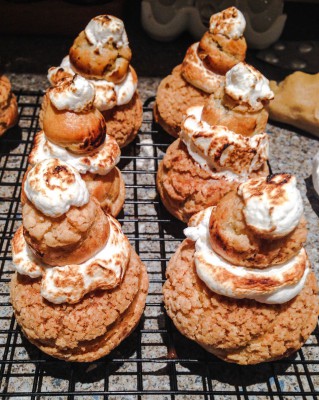
Serena
Hi Angela, can I ask you something about Patisserie of Christophe Felder? Did you find any errors in the ingredients? I’m interested in buying this book but the Italian version (I’m Italian) is full of errors, apparently the author is aware of it even though it’s not his fault.
I’m trying to understand if the English version is faithful to the original.
Thanks a lot,
Serena
patisseriemakesperfect
Hi Serena,
Thanks for your message, I think the English version is very accurate. If there is a particular recipe you would like to try or cross-reference against your Italian version, let me know and I can take some photos and send them to you, if you give email me at hello@patisseriemakesperfect.co.uk
Best wishes
Angela
Jacqueline Morris
Interested in the Felder book you mentioned, but it would be great if you could let me know the name of the book and full name of the author.
Thanks
Jessica A
Hi Angela,
I read your review about Philippe Conticini’s LPdR in English since I’m interested in purchasing one. Thanks so much for your experiences and reviews from baking recipes from his book. I’m curious, even though it seems that the recipe lacks of explanation, how do you rate in terms of flavour? Is it nice? Do you find any errors in terms of the amount of ingredients used? By the way, I love Christophe Felder’s book too, I call it “Pink Patisserie” book haha. Since you are learning about patisserie like I am now, I strongly recommend you to buy Jacquy Pfeiffer’s The Art of French Pastry for your next book (http://www.amazon.co.uk/The-French-Pastry-Jacquy-Pfeiffer/dp/030795935X). I can say that this is the best patisserie book that teaches you the really basic and fundamental patisserie. While it has less amount of recipe compared to Felder’s extensive lists of recipes, Jacquy’s has more meticulous and comprehensive explanations and instructions in making basic pastry recipes. I have made nearly 80% of the recipe from Jacquy’s and found how precious the book is. I can tell more why this book is no. 1 in my heart now (how I wish there are other books like his, I will surely purchase), but I guess I should stop now^^. By the way, have you tried any recipes from Laduree: The Sweet book? I am thinking about checking it out, but it seems that Laduree may have similar format with Concini’s LPdR (e.g. good for source of inspiration, lack of clear explanation, etc).
patisseriemakesperfect
Hi Jessica,
Thank you so much for your comments and the book recommendations. I didn’t know that Laduree had a book out. There is another book that is on my list of books to purchase by a Scottish patissier and chocolatier and his Japanese wife, that book is http://www.amazon.co.uk/Patisserie-Masterclass-Classic-Contemporary/dp/1909342211/ref=sr_1_1?ie=UTF8&qid=1404129922&sr=8-1&keywords=William+Curley. I think there are lots of step-by-step instructions and tips on chocolate work and decoration.
Now, back to the LPDR book, everything I have made has tasted wonderful, but it does require some guess work. Most of the serving sizes are wrong, some recipes don’t list what size tin you need to use (particularly useful when making tarts) and there are some recipes I don’t think I will ever attempt because some of the instructions are lacking.
The photos and the style of the book is beautiful, it could be accused of being more of a coffee table book than a practical book to work from. You seem to have a really good knowledge of patisserie though and I think you will be fine baking from it. I have had lots of success, but I would recommend testing a recipe first, before baking it for a special occasion.
Thanks again for commenting and for the recommendations.
Jessica A
William and Suzue Curley’s book is on my list too. Their entremets are beautiful. Thank you for your inputs, Angela. Now I am still debating whether I should go for it or not haha. Thanks once again
Jodie
nice job angela! i have to tell you that my favorite part of this recipe is how you’ve applied what you’ve learned from past recipes and how you improvise when you know something has not worked for you. so glad the choux turned out well! i can’t remember from the past recipes but could you freeze the extra choux and streusel for future use? i do love streusel, especially on muffins. these little nuns are so cute, they look and sound quite tasty! x
x
patisseriemakesperfect
Jodie – thanks very much, these tasted really nice and you needed a fork to eat them. Which to me is the sign of a truly decadent cake!
Choux pastry can be frozen uncooked or cooked but without filling. Streusel is really nice, I made some last night for a pie I was practising.
Thanks for following the blog and for commenting. xx